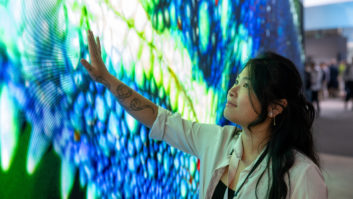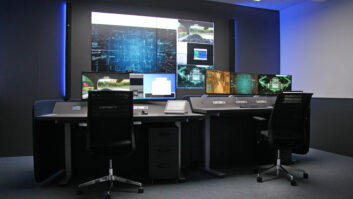In a complex world, there is always an impulse towards making things simpler and more efficient. Pro AV is no exception, and as applications have become more intricate – for example, in conferencing or control rooms – there has been an increasing appetite for solutions that can streamline operations and optimise systems management.
Now these imperatives are set to receive an historic boost in the form of technologies that utilise Artificial Intelligence (AI) and/or Machine Learning (ML). At least, that is what many observers are suggesting – and there’s no denying the hugely exciting predictions being generated about these technologies by research institutions and other organisations around the world.
As reported by Fortune in March 2023, the new report issued by Bank of America (BofA) is a case in point. Suggesting that AI is now on the brink of its own “iPhone moment”, BofA goes on to predict that the global economic impact of the technology could reach $15.7 trillion by 2030.
 The rise of tools such as ChatGPT that can understand natural language is perceived to be a major milestone in the maturity of the sector, with BofA’s report stating: “We are at a defining moment – like the internet in the ‘90s – where AI is moving towards mass adoption, with large language models like ChatGPT finally enabling us to fully capitalise on the data revolution.”
The rise of tools such as ChatGPT that can understand natural language is perceived to be a major milestone in the maturity of the sector, with BofA’s report stating: “We are at a defining moment – like the internet in the ‘90s – where AI is moving towards mass adoption, with large language models like ChatGPT finally enabling us to fully capitalise on the data revolution.”
BofA also lists four reasons why AI is set to have a seismic impact, namely democratisation of data, unprecedented mass adoption, ‘warp-speed’ technological development, and abundant commercial uses. And although it’s still relatively early days, it’s not difficult to see how these four trends are already in evidence across pro AV.
DEFINITIVE ARTICLE
But first, a quick word on definitions. AI and ML have entered the lexicon so quickly, so decisively, that it’s sometimes easy for their precise meanings to be overlooked. Indeed, there have been plenty of instances where AI and ML have been used interchangeably, which is incorrect. The definitions provided by Google (which, let’s face it, should know!) are as concise as any you are likely to encounter:
• “AI is the broader concept of enabling a machine or system to sense, reason, act or adapt like a human”
• “ML is an application of AI that allows machines to extract knowledge from data and learn from it autonomously”
By extension, it can also help to see AI as the overarching term – the ‘umbrella’ – that sits above a whole host of approaches and algorithms. Notes Google: “Machine learning sits under that umbrella, but so do other major subfields, such as deep learning, robotics, expert systems, and natural language processing”.
With all that in mind, let’s take a quick tour of the main aspects of pro AV where we can expect to see AI and ML applied in the coming years.
TAKE CONTROL
It’s relatively easy to see why control rooms is one of the areas in which these technologies are currently generating the most excitement. Not only is it a space where automation could ease a lot of repetitive processes – from camera selection to collecting and monitoring operational data – it’s also one where there is a significant potential for AI & ML to support and enhance decision-making.
This has been a recurring theme in Installation during the past 18 months. Reporting on last year’s ISE Control Rooms Summit, it was noted that Mehmet Kaya, VP sales EMEA at Barco, had highlighted AI’s scope for development in aspects of “workflow automation” and “decision-making support” for operators confronted with more autonomous sub-systems in intelligent control deployments.
Kaya’s Barco colleague, segment marketing director of large video wall experiences Piet Vanhuyse, expanded on these observations in an interview with me conducted in June 2022. There are some aspects such as camera systems that “already have AI applied”, he said, while in a more general sense deployment is bound to be partly determined by control room operators: “Looking at control and what they need to do… and the fact that [many are] going to be dealing with a bigger number of sources coming in, and a growing amount of data. The inputs are more complex, and the outputs are expected to be better because of the complexity of the inputs.”

AI’s role in intelligent control room applications was also addressed during Datapath’s first-ever Channel Partner Conference, held in Amsterdam last September. For instance, the talk given by International Critical Control Rooms Alliance chair Peter Prater hinted at the notion that automation technologies could help pave the way for a new phase of more versatile control rooms.
Hence Prater’s outlined vision of an in-the-round “futuristic control room” that includes cross-organisational systems integration, task-oriented working positions, and multi-disciplinary central visualisation experiences. Exploiting AI, ML and the latest AV, such a control room could be employed by multiple organisations or agencies, “driven by the need to save money while delivering more joined-up outcomes”.
PRODUCTIVE AREAS
If control rooms and related environments are likely to be the ‘flag-bearer’ for AI & ML in pro AV – in the same way that sports often fulfils that function for new developments in broadcast technology – then you nonetheless don’t have to look far for other spaces in which their deployment is set to become more ubiquitous.
Virtual production and other areas of visual effects are set to comprise one growth area, not least as they present a very specific challenge that can be addressed. As Stephan Ukas-Bradley, VP solutions – Americas, for ARRI, explained recently: “The technology and processes required to design and engineer LED volumes are still complex. However, eventually the cost of LED technology will come down and processes will standardise, simplify and move towards automation. This will reduce the complexity and risk, which will certainly open up the technology to wider sectors.”
Remote/virtual conferencing is another area where adoption appears to be on the fast-track. For example, in a way that has few recent parallels, the sharp rise in virtual meetings during the pandemic has shone a spotlight on audio quality – and the need to reduce or remote unwanted noises and audio artefacts. This is already being addressed with a new generation of products such as the Shure IntelliMIx Room DSP software, which from version 3.1 onwards includes an AI Denoiser audio processor that distinguishes between noise and speech. It reduces the noise with virtually no audible impact on the speech – including instances when there is an overlap.
CAMERA AUTOMATION
Increased automation in camera tracking for meetings seems to be another dead-cert [check out our smart camera feature in the the March/April edition of Installation]. Speaking to me in December 2022, Crestron Europe VP and general manager Annelies Kampert highlighted the use of AI tracking technology in its Crestron Sightline Experience, which comprises a complete ecosystem of hybrid meeting technology: “The algorithm cuts between speakers and frames them automatically, following the natural ebb and flow of meeting conversations without camera operators. By keying on individual speakers, the camera, display and audio solutions, working in concert, increase engagement and lessen fatigue.”

More AI-led video analytics solutions are bound to follow, too. In this regard, Sony Pro’s Video Edge Analytics solutions are surely a trailblazer. With optional licenses for handwriting extraction, chromakey-less CG overlay for supporting graphics and PTZ auto-tracking, the range includes an Edge Analytics Appliance (REA-C1000), designed to create impactful video presentation content “which previously would have required significant time, expense and human resource to produce”.
EXISTENTIAL ECOSYSTEM
That there will soon be a sizeable ecosystem of AI-enabled technologies serving pro AV is in little doubt. What may take a little longer to emerge is a widespread sense of confidence in, and ease around, AI solutions. In particular, a wave of major data breaches around the world have, quite rightly, prompted an ongoing debate about the security and stability of data protection. Given the colossal data gathering and management implications of AI and ML, it’s an issue that will have to be addressed – and with complete transparency – if they are to be accepted into the public consciousness.
Encouragingly, this is a challenge that is increasingly being recognised by public and private stakeholders, with many urging the introduction of new guidelines, including around the use of algorithms. As a recent article for Public Technology, focusing on the scope for AI in the delivery of public services, observed: “In order to realise that potential over the long-term […] it is vital that we earn the public’s trust that AI is being used in a way that is safe and responsible.”
With no shortage of commentators expressing longer-term societal and geopolitical concerns about AI & ML, it’s possible that the acceptance period will be longer than most – and that’s no bad thing. But as and when a mass-adoption point does arrive, there’s no doubt that pro AV will find plenty of reason to participate in this particular technology revolution.







